Now that we’ve celebrated the 45th anniversary of Apollo 13 and completed our series “13 MORE Things That Saved Apollo 13” and we want to see how well you’ve been paying attention! Here are 13 questions about the mission taken from this series as well as our original “13 Things” series that was published in 2010. The questions follow and the answers are listed below. Let us know how you do!
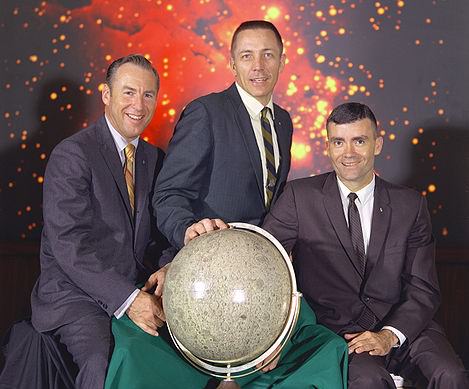
1. Name the three astronauts on Apollo 13 and their roles/official titles in the mission.
2. What caused only 12 men to walk on the Moon instead of 14?
3. Why was a newspaper reporter’s training helpful in saving Apollo 13?
4. Who was credited in the Apollo 13 movie with the statement “Failure Is Not an Option” but never actually made that statement.
5. What Apollo astronaut’s statue is in the Halls of Congress?
6. Blackout on reentry lasted approximately 87 seconds longer than expected. Explain some theories on why this was so.
7. Explain why you think the hatch would not seal/close property when it worked correctly at the time of jettisoning the lander in preparation for reentry?
8. What everyday item(s) assisted Apollo 13 in finding the way back to Earth?
9. What Hollywood movie predicted 7 facets of Apollo 13’s rescue?
10. Who is the only man to have orbited the Moon on two missions without landing on the Moon?
11. Which astronaut on Apollo 13 became ill during the flight?
12. Apollo 13 marked the first time the 3rd stage of the Saturn V rocket did not either burn up in Earth’s atmosphere or end up in a heliocentric orbit. Where did it land?
13. What was the duration of the Apollo 13 Mission?

Answers:
1. James A. Lovell, Jr. Commander, John L. Swigert, Jr., Command Module Pilot, Fred W. Haise, Jr., Lunar Module Pilot.
2. Even though there were 7 Apollo missions that were supposed to land on the Moon with 2 astronauts walking on the Moon in each mission, , Apollo 13 never landed because of the accident. Read more about the explosion and why the timing of the accident was important to the crew’s survival here.
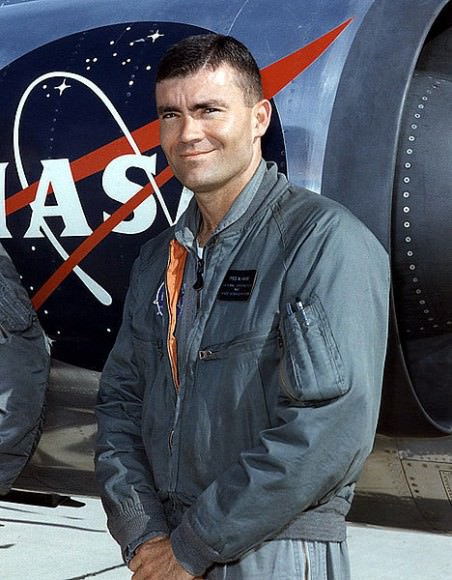
3. Fred Haise had been a newspaper stringer for a small newspaper in Mississippi when he was younger, taking notes and editing them for his local Mississippi paper’s stories. Utmost among reporters is accuracy in quoting sources. The transmitted words from Mission Control had to be flawlessly transcribed if the crew was to survive, and Haise did an amazing job. Read more about it in the article in the original “13 Things,” Charlie Duke’s Measles.
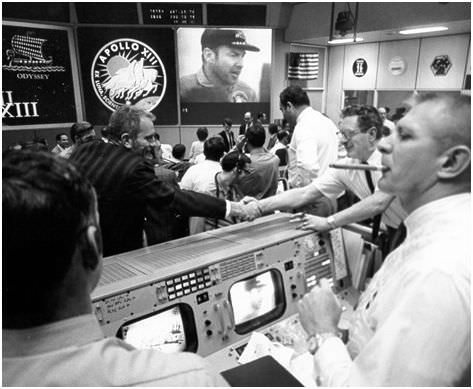
4. In the movie Apollo 13, Gene Kranz says the line, “Failure is not an option!” Even though Kranz never actually said those words during the “real” Apollo 13 mission, he liked the phrase so much that he used it for his autobiography. Who said it? Jerry Bostick, who was the Retrofire Officer and Flight Dynamics Officer in Mission Control during the Mercury, Gemini, Apollo and Skylab programs, said it during interviews for the Apollo 13 movie. Read more about the phrase and why they used it the movie here.
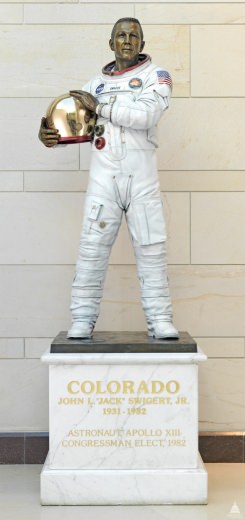
5. A statue of Jack Swigert is located in Emancipation Hall at the U.S. Capitol Visitor Center. Swigert was elected to Colorado’s Sixth Congressional District in 1982, but he died on December 27, 1982, before taking office. Read more about the Swigert and the statue here. Read more about the traits that made Swigert such a valuable crew member on Apollo 13 in “Charlie Duke’s Measles.”
6. The longer than expected blackout period has never been fully explained, but several explanations have been offered. They include: the spacecraft coming in on a shallower trajectory that would result in a longer period in the upper atmosphere where there was less deceleration of the spacecraft and the communication signal skipping like a stone over layers of the upper atmosphere because of the shallow entry angle. Read more about the ‘shallow’ reentry and the communications blackout in our article here.
7. No one has fully explained why the hatch wouldn’t close immediately after the accident while it worked fine at reentry. It may have been because the two spacecraft (Command Module and Lunar Module) were skewed or twisted right after the explosion, but the position normalized later. Read more at the original series part 2, “The Hatch That Wouldn’t Close,” and part 8, “The Command Module Wasn’t Severed.”
8. The Apollo 13 crew used things like watches, flashlights, pencils, pens and of course duct tape to help save the mission. Read more about them at “‘MacGyvering’ with Everyday Items” and “Duct Tape.”
9. The 1969 movie Marooned depicts three astronauts who survive an accident in space, but their lives hang in the balance as the people in Mission Control at NASA work night and day to figure out a way to bring the spacefarers home safely. Read how the movie inspired a NASA engineer to consider options for recharging the LM batteries in the original series part 11, “A Hollywood Movie.”
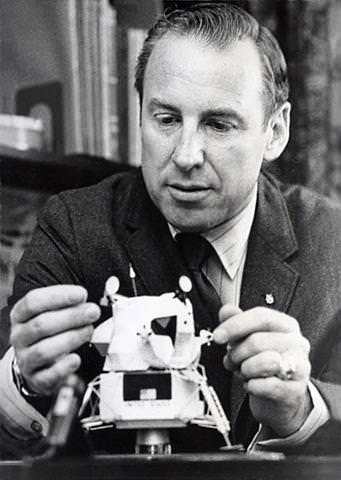
10. Jim Lovell took 2 trips to the Moon but never landed. He was on Apollo 8, which became the first human mission to orbit the Moon in 1968 and on Apollo 13, which didn’t land on the Moon because of the oxygen tank explosion in the Service Module.
11. Fred Haise got a kidney infection during the mission, possibly from not drinking enough water. Water was one of the resources that was scarce because of the inoperable fuel cells, which normally creates water as a byproduct of producing electrical power. Learn more about the Apollo era fuel cell at the Smithsonian Air & Space Museum.
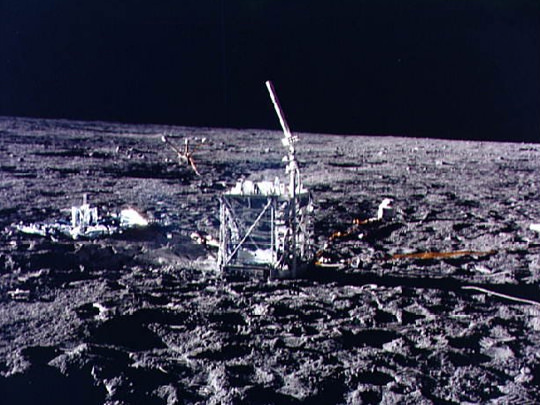
12. The Saturn V 3rd stage (S-IVB) was part of a science experiment and was crashed into the Moon. The Apollo 12 mission had left a seismometer on the Moon, and an impact could produce seismic waves that could be registered for hours on the seismometer. This would help scientist to better understand the structure of the Moon’s deep interior. Find out more about the experiment and the communications problem caused by the 3rd stage at our article, “Detuning the Saturn V’s 3rd Stage Radio.”
13. Mission duration 142 hours 54 minutes 41 seconds (or 5 days, 22 hours, 54 minutes, 41 seconds.) Read more about reentry at “The Mysterious Longer-Than-Expected Communications Blackout” and “The Trench Band of Brothers.”
Our thanks, once again, to NASA engineer Jerry Woodfill who originally came up with the ideas for the “13 Things” and “13 MORE Things That Saved Apollo 13.”


Thanks for all the work you’ve put into this series! It’s the most complete anthology of Apollo 13 events I’ve ever read or watched on TV.
So now… I expect to see an e-book? or even a NASA TV, Nat’l Geo or Sci Channel documentary? After all, the script is practically written! Piece of cake…
Question #12 is inaccurate. The third stages from all the crewed missions prior to Apollo 13 are believed to be in heliocentric orbit, including Apollo 12’s, which has been designated as asteroid J002E3.
Thanks, I’ve amended the question, as the S-IVBs for the Apollo test flights (and then later the Skylab missions) did burn up in Earth’s atmosphere.
i’m sorry nancy. i kept cheating. 🙂